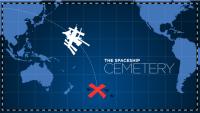 First of all, notwithstanding the name, there is no point, as in point of land, to Point Nemo. Which may be exactly the point. Point Nemo is the point in the ocean furthest from any land mass. Named for Captain Nemo of Jules Verne’s classic sci-fi novel 20,000 Leagues Under the Sea, this point sits at 48⁰25.6’ South latitude and 123⁰23.6’ West longitude. The closest land is is 2,700 kilometers south to Antarctica. The waters near Point Nemo are referred to as the South Pacific Ocean Uninhabited Area. The waters may be uninhabited but they are not empty. These lonely waters are the site of the Spacecraft Cemetery. As reported by Gizmodo:
First of all, notwithstanding the name, there is no point, as in point of land, to Point Nemo. Which may be exactly the point. Point Nemo is the point in the ocean furthest from any land mass. Named for Captain Nemo of Jules Verne’s classic sci-fi novel 20,000 Leagues Under the Sea, this point sits at 48⁰25.6’ South latitude and 123⁰23.6’ West longitude. The closest land is is 2,700 kilometers south to Antarctica. The waters near Point Nemo are referred to as the South Pacific Ocean Uninhabited Area. The waters may be uninhabited but they are not empty. These lonely waters are the site of the Spacecraft Cemetery. As reported by Gizmodo:
The Spacecraft Cemetery is the final resting place of 145 of Russia’s Progress autonomous resupply ships, 4 of Japan’s HTV cargo craft, and 5 of the ESA’s Automated Transfer Vehicles. 6 Russian Salyut space stations and the venerable Mir space station lie alongside the freighters that once supplied them.
There’s a lot of space history down there, but of course, none of these spacecraft are just sitting neatly on the ocean floor in one piece. Or even two pieces. Re-entering the Earth’s atmosphere is a violent, destructive process for any object that tries it, whether it’s a meteor or a space station. Plunging into the atmosphere at high speed generates enough heat to burn up even rock or metal. That’s why so few large meteors make it to Earth; most of their mass burns away as they fall through the atmosphere. That’s also why piloted vehicles like the Space Shuttle or the Soyuz capsules are built with thermal shielding, to protect the spacecraft and its occupants on the way down.
Those high-tech remains are spread out over a huge distance. The South Pacific Ocean Uninhabited Area stretches about 3,000 kilometers from north to south, by about 5,000 kilometers from west to east. And any given spacecraft can scatter debris over a huge swath of ocean. Mir left a debris trail 3,000 kilometers long and 100 kilometers wide when it went down.
“Even in controlled entries, this will not be a point landing,” explained Holger Krag, head of ESA’s Space Debris Office, in late 2013, just before the ESA’s third ATV, Edoardo Amaldi, joined its predecessors in the deep. “The nature of this break up process brings it that we will have to clear quite a large area to make sure that all fragments will fall within the designated area, because they will not fall in one spot.”
A few days before a spacecraft’s de-orbit, the space agency who owns the spacecraft will notify aviation and maritime authorities in Chile and New Zealand, who share responsibility for traffic in the remote stretch of ocean. They offer information about expected re-entry times and where debris is likely to fall. Then the craft can begin its controlled plunge through the atmosphere to its final interment in these waters. It’s up to the aviation and maritime authorities to issue notices to pilots and merchant vessels, warning them to avoid the area.
The Spacecraft Cemetery lies on the boundary between the bathyal zone and the abyssal zone, 4 kilometers beneath the waves. It’s dark here, because no sunlight penetrates water this deep. Few fish live this far down; these depths are home to sponges, sea stars, squid, octopi, whales, and viperfish. Temperatures hover between 2⁰ and 4⁰C. For ships used to the cold and darkness of space, it just might feel like home.

That’s if they haven’t lost control of it.
The recent out of control Russian resupply craft was said to land in both the Pacific in one article, in another they said it hit the Indian Ocean.
Then there are the rocket engines, depending on who launched them, they could be anywhere, even thd Atlantic or the Pacific.
Pingback: Zeegraf voor ruimteschepen | Bootjesgek.nl
Pingback: This Week’s New York History Web Highlights | The New York History Blog